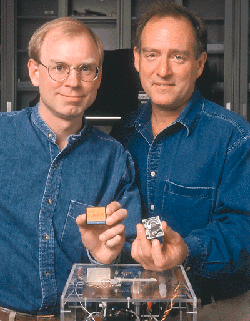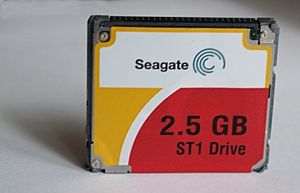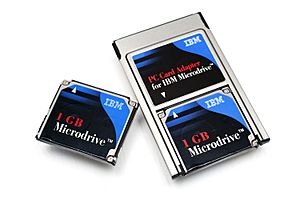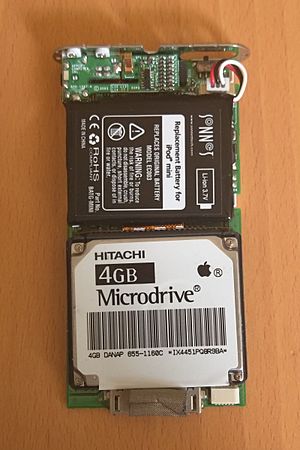Microdrive facts for kids
| MicroDrive1GB.jpg
1 GB IBM Microdrive
|
|
| Media type | Hard disk drive |
|---|---|
| Encoding | RLL |
| Capacity | 170 MB - 16 GB |
| Developed by | IBM, Hitachi |
| Dimensions | 42.0 mm × 36.0 mm × 5.0 mm |
| Usage | Portable devices, notebooks |
The Microdrive was a special type of very small hard disk drive (HDD). It was first made by IBM and later by Hitachi. These tiny storage devices were designed to fit into CompactFlash (CF) Type II slots. Other companies also made similar small drives, and people often called them "microdrives" too. By 2010, Microdrives were not used much anymore. Newer flash memory cards became much better. They could store more data, work faster, were tougher, and cost less.
Contents
How the Microdrive Was Invented
Before the 1-inch Microdrive, there was a slightly larger 1.3-inch hard drive. It was called the "Kittyhawk" and was made by Hewlett-Packard in 1992. This drive could hold 20 MB, and later 40 MB. It was very small for its time, weighing about 28 grams. However, the Kittyhawk was not very successful and did not stay on the market for long.
Developing the Tiny Drive
The idea for the Microdrive came from an IBM scientist named Timothy J. Reiley. He worked at the Almaden Research Center in San Jose, California. Timothy wanted to make a very small hard drive that could store a lot of information. This drive would be perfect for mobile devices like cameras.
Another scientist, Thomas R. Albrecht, worked with Timothy to design the drive. At first, they thought about using tiny machine parts called Microelectromechanical systems. But Thomas decided it would be better to use smaller versions of regular hard drive parts. This made the project less risky and cheaper.
A team at IBM Fujisawa in Japan, led by Hideya Ino, was very excited about the idea. They worked with the American researchers to build working models. These models helped convince other teams at IBM to support the project. Mitsuhiko Aoyagi and Kenji Kuroki from the Japan team helped launch the product. Bill Healey and John Osterhout from San Jose helped with the business side and marketing.
When the Microdrive First Came Out
In September 1998, IBM announced the Microdrive in North America. They said it was about the size of a large coin. It weighed less than a single AA battery. It could hold more data than 200 old floppy disks! IBM expected it to be available by mid-1999.
On June 24, 1999, IBM Japan announced the 340 MB Microdrive. It cost about $475 USD. It was planned to be used in digital cameras and other small, handheld devices. Soon after, Microtech International became the first company to sell the 340 MB Microdrive in North America.
In June 1999, IBM launched the first Microdrives. They came in 170 MB and 340 MB sizes. The price was $499. These drives were 42.0 mm × 36.0 mm × 5.0 mm. They fit perfectly into CompactFlash Type II card slots.
A year later, in June 2000, IBM released a second version. These had more storage: 512 MB and 1 GB. The 512 MB model cost $399, and the 1 GB model was $499.
After IBM and Hitachi joined their hard drive businesses, Hitachi Global Storage Technologies kept making Microdrives. In 2003, Hitachi announced 2 GB and 4 GB models. The 4 GB model came out in February 2004 for $499. Then, in February 2005, a 6 GB model was released for $299. The 4 GB model's price dropped to $199. Hitachi even planned a smaller 1-inch drive called "Mikey" with 8-10 GB of storage. It would weigh only 14 grams!
By 2007, Microdrive sales were going down. Hitachi stopped making 1-inch hard drives. They sold only about 3,000 1-inch drives in three months in 2007. Hitachi decided to focus on bigger hard drives instead.
Other Companies Make Small Drives
Seagate's Tiny Drives
In 2004, Seagate also started making small hard drives. They made 2.5 GB and 5 GB drives. These were the same size as the IBM Microdrive. Seagate called them 1-inch hard drives or CompactFlash hard drives. They were also known as the Seagate ST1. In 2005, Seagate released an 8 GB model. Seagate also sold a product called the Pocket Hard Drive. It was a standalone device shaped like a hockey puck with a USB cable.
Seagate launched their 6 GB mini drive in February 2005, on the same day as Hitachi.
Western Digital's Entry
In early 2005, Western Digital announced they would also make mini hard drives. They planned to have drives up to 6 GB by the second half of 2005.
In March 2006, Western Digital released a 6 GB external USB 2.0 microdrive. It was part of their Passport Pocket brand. This was a competitor to Seagate's Pocket Hard Drive. It was small, fast, and cost $130.
GS Magicstor's Drives
On July 16, 2003, a Chinese company called GS Magicstor announced its own 1-inch hard drive. It had a capacity of 2.4 GB. They planned to offer 2.2 GB and 4.8 GB drives later. However, in December 2004, Hitachi Global Storage Technologies sued GS Magicstor. Hitachi said GS Magicstor was using their patented ideas without permission.
Why Microdrives Stopped Being Made
By 2006, flash-based CompactFlash cards became much better. They could store more data than Microdrives. Over time, flash cards also became cheaper. This made Microdrive technology old-fashioned. As of July 2012, no one makes 1-inch hard drives anymore. Hitachi also stopped making its Microdrive product.
Microdrive Models Over Time
Here's a timeline of when larger Microdrive sizes were released:
| Date | ||||
|---|---|---|---|---|
| June 1999: | IBM releases 170, 340 MB Microdrives | |||
| June 2000: | IBM releases 512 MB, 1 GB Microdrives | |||
| 2003: | 2 GB, 4 GB (Hitachi) | |||
| 2004: | 2.5 and 5 GB (Seagate) | |||
| February 2005: | 6 GB (Hitachi), 8 GB (Seagate) | |||
| 2006: | 8 GB (Hitachi) | |||
Good Things About Microdrives
- Until 2006, Microdrives could store more data than CompactFlash cards.
- They could be written to many more times. This made them good for certain computer uses.
- Microdrives were better at handling power loss while saving data. Flash storage sometimes had problems if power was lost at the wrong moment.
- They weighed less than a roll of camera film.
- They could store thousands of pictures (for cameras of that time).
- Sometimes they came with an adapter to use in laptops.
- A 4GB Microdrive could hold as much as about 2700 old 1.44 MB floppy disks!
Things That Weren't So Good About Microdrives
- By 2006, CompactFlash cards and USB flash drives could store much more data. For example, a 512 GB CF card can hold 42 times more than the biggest Microdrive.
- Because they had moving parts, Microdrives were more sensitive to drops and temperature changes than flash memory. If you dropped a Microdrive from 4 feet onto a hard floor, it might break. CF cards could survive much higher falls.
- Microdrives were not as fast as the best CompactFlash cards. They worked at about 4–6 megabytes per second. Some CF cards could work at 45 megabytes per second. This could be a problem for photographers taking many large pictures quickly.
- They needed a moment to "spin up" when they had been resting. This took about 1 second.
- They were not designed to work at very high altitudes (over 10,000 feet).
- Only large-capacity models were made because smaller ones were not profitable.
- Unlike flash storage, Microdrives needed power all the time to keep spinning. This used up battery life. Devices like the iPod mini would turn the drive off often to save power.
- Microdrives were thicker than flash-based CF cards. They needed a special Type II slot. Many newer cameras only had thinner Type I slots.
- Some CF card readers did not provide enough power for a Microdrive to work.
- Some special "OEM Only" drives used the CompactFlash shape but needed a different power setup. They would not work in regular readers.
Microdrive Models by Company
IBM Microdrive
- 170 MB
- 340 MB
- 512 MB
- 1 GB
- 4 GB
- 8 GB
- 16 GB
The Computer History Museum has several examples of Microdrives.
Hitachi Microdrive
- 512 MB
- 1 GB
- 2 GB
- 3 GB
- 4 GB
- 5 GB
- 6 GB
- 8 GB
Both IBM and Hitachi models had 128 KB of cache memory.
GS Magicstor
Seagate ST1
- 2.5 GB
- 4 GB
- 5 GB
- 6 GB
- 8 GB
- 12 GB
These Seagate models had 2MB of cache memory.
Sony Compact Vault
- 2 GB (a re-branded Hitachi drive)
- 4 GB (a re-branded Hitachi drive)
- 5 GB (a re-branded Seagate drive)
- 8 GB (a re-branded Seagate drive)
Toshiba
- 2 GB
- 4 GB
Cornice
- 2 GB
- 4 GB
- 8 GB
Western Digital
- 6 GB
See also
 In Spanish: Microdrive para niños
In Spanish: Microdrive para niños
- Digital camera
- Hard disk drive
- HP Kittyhawk microdrive







